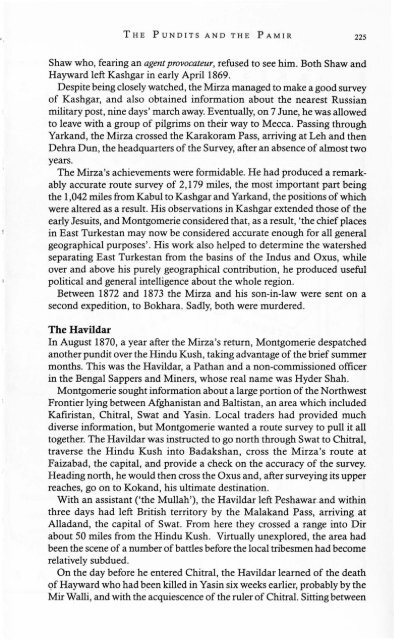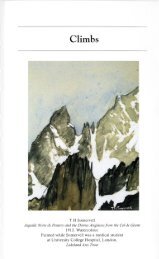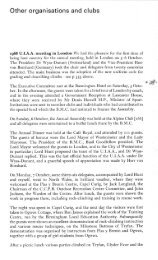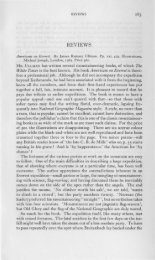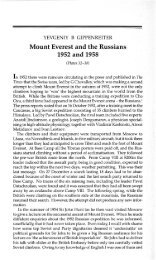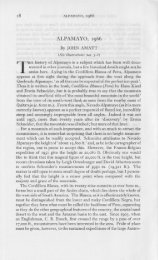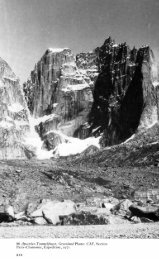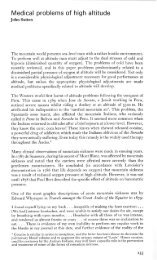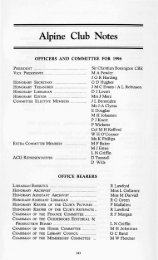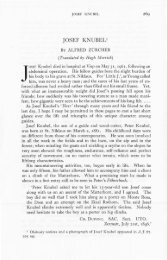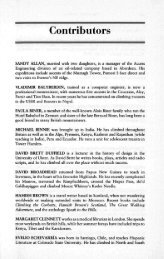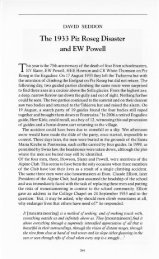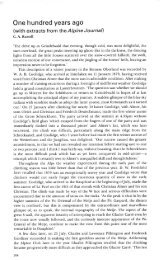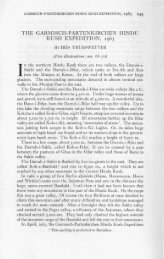AJ 2002 222-229 Ward Pundits.pdf - Alpine Journal
AJ 2002 222-229 Ward Pundits.pdf - Alpine Journal
AJ 2002 222-229 Ward Pundits.pdf - Alpine Journal
Create successful ePaper yourself
Turn your PDF publications into a flip-book with our unique Google optimized e-Paper software.
THE PUNDITS AND THE P AMIR 225<br />
Shaw who, fearing an agentprovocateur, refused to see him. Both Shaw and<br />
Hayward left Kashgar in early April 1869.<br />
Despite being closely watched, the Mirza managed to make a good survey<br />
of Kashgar, and also obtained information about the nearest Russian<br />
military post, nine days' march away. Eventually, on 7 June, he was allowed<br />
to leave with a group of pilgrims on their way to Mecca. Passing through<br />
Yarkand, the Mirza crossed the Karakoram Pass, arriving at Leh and then<br />
Dehra Dun, the headquarters of the Survey, after an absence of almost two<br />
years.<br />
The Mirza's achievements were formidable. He had produced a remarkably<br />
accurate route survey of 2,179 miles, the most important part being<br />
the 1,042 miles from Kabul to Kashgar and Yarkand, the positions of which<br />
were altered as a result. His observations in Kashgar extended those of the<br />
early Jesuits, and Montgomerie considered that, as a result, 'the chief places<br />
in East Turkestan may now be considered accurate enough for all general<br />
geographical purposes'. His work also helped to determine the watershed<br />
separating East Turkestan from the basins of the Indus and Oxus, while<br />
over and above his purely geographical contribution, he produced useful<br />
political and general intelligence about the whole region.<br />
Between 1872 and 1873 the Mirza and his son-in-law were sent on a<br />
second expedition, to Bokhara. Sadly, both were murdered.<br />
The Havildar<br />
In August 1870, a year after the Mirza's return, Montgomerie despatched<br />
another pundit over the Hindu Kush, taking advantage of the brief summer<br />
months. This was the Havildar, a Pathan and a non-commissioned officer<br />
in the Bengal Sappers and Miners, whose real name was Hyder Shah.<br />
Montgomerie sought information about a large portion of the Northwest<br />
Frontier lying between Afghanistan and Baltistan, an area which included<br />
Kafiristan, Chitral, Swat and Yasin. Local traders had provided much<br />
diverse information, but Montgomerie wanted a route survey to pull it all<br />
together. The Havildar was instructed to go north through Swat to Chitral,<br />
traverse the Hindu Kush into Badakshan, cross the Mirza's route at<br />
Faizabad, the capital, and provide a check on the accuracy of the survey.<br />
Heading north, he would then cross the Oxus and, after surveying its upper<br />
reaches, go on to Kokand, his ultimate destination.<br />
With an assistant ('the Mullah'), the Havildar left Peshawar.and within<br />
three days had left British territory by the Malakand Pass, arriving at<br />
Alladand, the capital of Swat. From here they crossed a range into Dir<br />
about 50 miles from the Hindu Kush. Virtually unexplored, the area had<br />
been the scene of a number of battles before the local tribesmen hadbecome<br />
relatively subdued.<br />
On the day before he entered Chitral, the Havildar learned of the death<br />
of Hayward who had been killed in Yasin six weeks earlier, probably by the<br />
Mir Walli, and with the acquiescence of the ruler of Chitral. Sitting between


